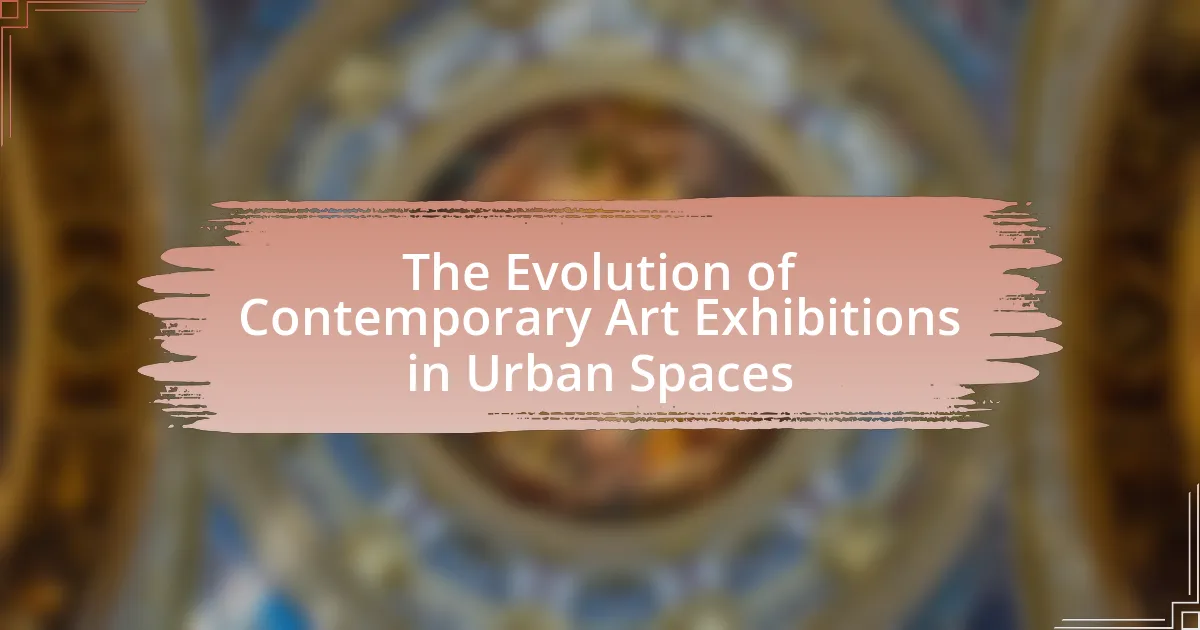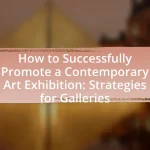The article examines the evolution of contemporary art exhibitions in urban spaces, highlighting significant transformations since the late 20th century. It discusses the shift from traditional gallery settings to public spaces, emphasizing the role of technology, community engagement, and inclusivity in making art more accessible. Key historical influences, such as industrialization and modernism, are explored, along with the impact of digital advancements on audience interaction. The article also addresses the significance of urban demographics, sustainability, and collaborative practices in shaping the themes and styles of contemporary art exhibitions, ultimately reflecting the dynamic relationship between art and urban life.
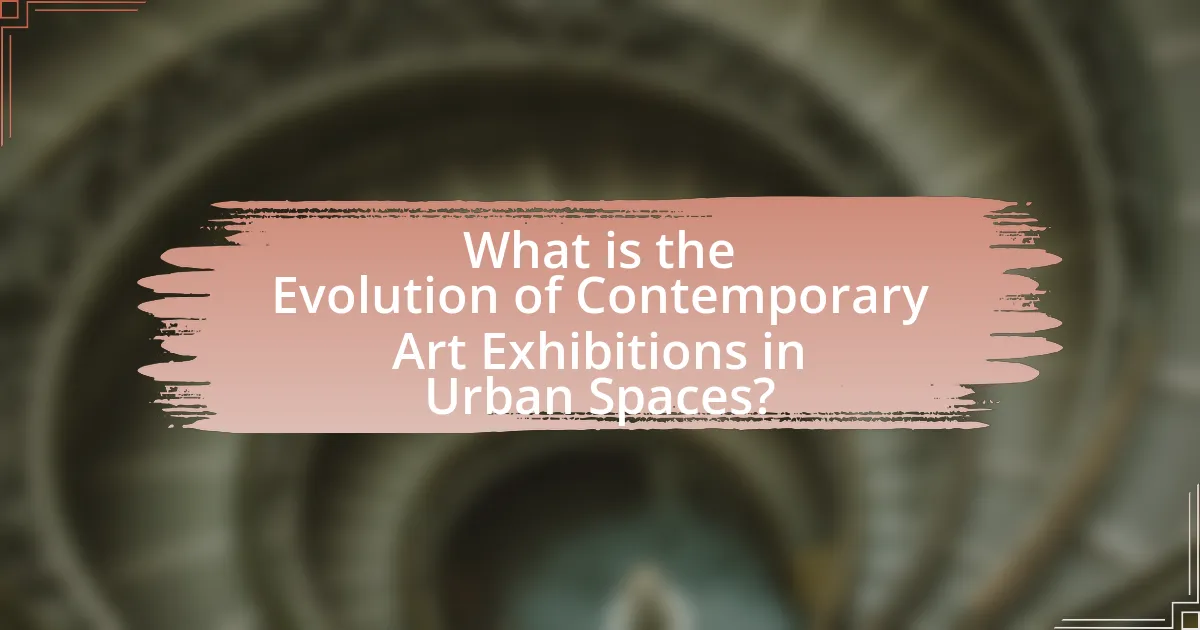
What is the Evolution of Contemporary Art Exhibitions in Urban Spaces?
The evolution of contemporary art exhibitions in urban spaces has transformed significantly since the late 20th century, reflecting changes in societal values, technology, and artistic practices. Initially, contemporary art was primarily showcased in traditional gallery settings, but the rise of public art initiatives and urban interventions has shifted exhibitions into open, accessible environments. This shift is evidenced by the proliferation of art festivals, such as the Venice Biennale, which began in 1895 but has increasingly included urban installations and site-specific works that engage with the public space. Furthermore, the integration of digital technology has allowed for innovative formats, such as augmented reality installations and interactive art, enhancing audience engagement and participation. This evolution underscores a broader trend towards democratizing art, making it more inclusive and reflective of diverse urban experiences.
How have contemporary art exhibitions transformed over time in urban environments?
Contemporary art exhibitions in urban environments have transformed significantly over time, evolving from traditional gallery spaces to more dynamic, interactive, and community-oriented experiences. Initially, exhibitions were primarily held in established galleries and museums, focusing on static displays of artwork. However, recent trends have shifted towards utilizing public spaces, such as parks and streets, to engage a broader audience and foster community involvement.
For example, events like the Venice Biennale and Art Basel have expanded their reach by incorporating outdoor installations and performances, making art accessible to diverse populations. Additionally, the rise of digital technology has allowed for innovative formats, such as virtual exhibitions and augmented reality experiences, further enhancing audience interaction. This transformation reflects a growing recognition of art’s role in urban life and its potential to address social issues, as seen in initiatives like the High Line in New York City, which integrates art into public infrastructure.
What historical factors influenced the development of contemporary art exhibitions in cities?
The development of contemporary art exhibitions in cities has been significantly influenced by factors such as industrialization, urbanization, and the rise of modernism. Industrialization in the 19th century led to the growth of cities, creating new spaces for cultural institutions and exhibitions. Urbanization further facilitated the accessibility of art to a broader audience, as cities became cultural hubs. The rise of modernism in the early 20th century introduced new artistic movements that challenged traditional forms and encouraged innovative exhibition practices, exemplified by events like the Armory Show in 1913, which showcased avant-garde art and transformed public perception of contemporary art. These historical factors collectively shaped the landscape of contemporary art exhibitions, making them integral to urban cultural life.
How have technological advancements impacted the presentation of art in urban spaces?
Technological advancements have significantly transformed the presentation of art in urban spaces by enabling interactive and immersive experiences. Innovations such as augmented reality (AR) and virtual reality (VR) allow artists to create dynamic installations that engage viewers in novel ways, enhancing their emotional connection to the artwork. For instance, the use of projection mapping has turned buildings into canvases, as seen in events like the Vivid Sydney festival, where light and sound are synchronized to create captivating visual narratives. Additionally, digital platforms facilitate wider accessibility, allowing art to reach diverse audiences through social media and online exhibitions, exemplified by initiatives like the Google Arts & Culture project, which has partnered with numerous museums to showcase art globally. These advancements not only redefine how art is experienced but also expand the possibilities for artistic expression in urban environments.
Why are urban spaces significant for contemporary art exhibitions?
Urban spaces are significant for contemporary art exhibitions because they provide a dynamic and accessible environment that fosters engagement with diverse audiences. These spaces often reflect the cultural, social, and political contexts of their surroundings, allowing artists to create works that resonate with local communities. For instance, public art installations in urban areas can attract thousands of viewers, as seen in events like the Venice Biennale, which showcases art in a city known for its rich history and architecture. Additionally, urban settings facilitate collaboration among artists, curators, and the public, enhancing the overall impact of the exhibitions. The integration of art into everyday urban life not only enriches the cultural landscape but also encourages dialogue and interaction among various stakeholders, making urban spaces vital for the evolution of contemporary art.
What role do public spaces play in the accessibility of contemporary art?
Public spaces significantly enhance the accessibility of contemporary art by providing open and inclusive environments for diverse audiences. These spaces allow for art to be experienced outside traditional galleries and museums, breaking down barriers related to location, cost, and exclusivity. For instance, public art installations and exhibitions in urban areas can attract a wider demographic, including those who may not typically engage with art due to socioeconomic factors. Research indicates that public art initiatives can increase community engagement and foster cultural dialogue, as seen in projects like the High Line in New York City, which transformed an abandoned railway into a vibrant public park featuring art installations. This accessibility promotes a broader appreciation of contemporary art and encourages participation from various community members.
How do urban demographics influence the themes and styles of art exhibitions?
Urban demographics significantly influence the themes and styles of art exhibitions by shaping the cultural narratives and aesthetic preferences that reflect the community’s identity. For instance, in cities with diverse populations, art exhibitions often showcase multicultural themes, highlighting various ethnic backgrounds and social issues relevant to those communities. This is evident in exhibitions like “The Black Experience” at the Museum of Contemporary Art in Chicago, which addressed African American culture and history, resonating with the city’s demographic composition. Additionally, urban areas with younger populations may lean towards contemporary and experimental art styles, as seen in the rise of street art and graffiti in cities like Berlin, where the youth culture drives artistic expression. Thus, the demographic makeup of urban environments directly informs the content and presentation of art exhibitions, making them more relevant and engaging to local audiences.
What are the key characteristics of contemporary art exhibitions in urban settings?
Contemporary art exhibitions in urban settings are characterized by their accessibility, diversity, and integration with the urban environment. These exhibitions often take place in non-traditional spaces such as warehouses, public parks, and abandoned buildings, allowing for innovative presentation methods that engage a broader audience. The use of technology, such as augmented reality and interactive installations, enhances visitor experience and participation. Additionally, contemporary exhibitions frequently emphasize social issues and community involvement, reflecting the cultural dynamics of urban life. For instance, the 2019 “The Invisible Man” exhibition in New York City utilized public spaces to address themes of identity and visibility, demonstrating how urban settings can amplify the relevance of contemporary art.
How do curatorial practices differ in urban exhibitions compared to traditional galleries?
Curatorial practices in urban exhibitions differ from those in traditional galleries primarily in their focus on site-specificity and community engagement. Urban exhibitions often utilize public spaces, integrating art into the urban environment, which requires curators to consider the social and cultural context of the location. For instance, curators may collaborate with local artists and communities to reflect the unique identity of the area, as seen in projects like the High Line in New York City, where art is embedded within the landscape and engages passersby directly. In contrast, traditional galleries typically emphasize a controlled environment, prioritizing the artwork’s presentation and the curator’s vision over community interaction. This distinction highlights how urban exhibitions aim to democratize art access and foster dialogue among diverse audiences, while traditional galleries maintain a more exclusive atmosphere.
What types of art are commonly featured in urban exhibitions?
Urban exhibitions commonly feature street art, contemporary installations, photography, and multimedia art. Street art, including murals and graffiti, reflects urban culture and social issues, often transforming public spaces into galleries. Contemporary installations engage viewers through interactive elements and site-specific designs, while photography captures urban life and its dynamics. Multimedia art combines various forms, such as video and sound, to create immersive experiences that resonate with urban audiences. These art types collectively highlight the relationship between art and the urban environment, showcasing the evolving nature of contemporary art in city settings.
How do contemporary art exhibitions engage with local communities?
Contemporary art exhibitions engage with local communities by fostering participation and collaboration through interactive programs and community-driven projects. These exhibitions often include workshops, artist talks, and collaborative art-making sessions that invite local residents to contribute their perspectives and creativity. For instance, the “Community Art Project” in Chicago involved local artists and residents in creating public murals, which not only beautified the neighborhood but also strengthened community ties and cultural identity. Such initiatives demonstrate that contemporary art exhibitions can serve as platforms for dialogue, empowerment, and social change, effectively integrating art into the fabric of local life.
What challenges do contemporary art exhibitions face in urban environments?
Contemporary art exhibitions in urban environments face several challenges, including high operational costs, limited space, and audience engagement. High operational costs arise from renting venues, marketing, and staffing, which can strain budgets and limit the scope of exhibitions. Limited space in densely populated urban areas restricts the size and scale of installations, making it difficult for artists to fully realize their visions. Additionally, engaging diverse audiences poses a challenge, as urban environments often have varied demographics with differing interests and accessibility needs. These factors collectively hinder the effectiveness and reach of contemporary art exhibitions in urban settings.
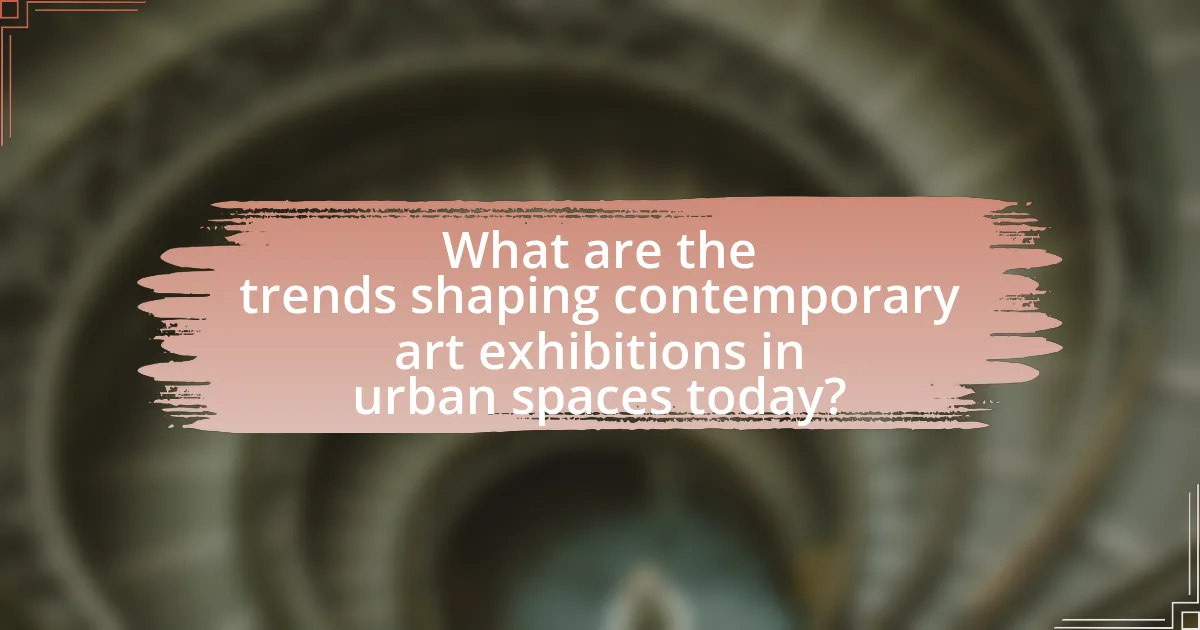
What are the trends shaping contemporary art exhibitions in urban spaces today?
Contemporary art exhibitions in urban spaces today are increasingly shaped by digital integration, community engagement, and sustainability. Digital integration allows for immersive experiences through augmented reality and virtual reality, enhancing viewer interaction and accessibility. Community engagement emphasizes local artists and participatory projects, fostering a sense of belonging and cultural dialogue. Sustainability is prioritized through eco-friendly practices and materials, reflecting a growing awareness of environmental issues. These trends are supported by data indicating that urban art initiatives involving community participation have increased by 30% over the past five years, demonstrating their rising importance in contemporary art discourse.
How is social media influencing the promotion of urban art exhibitions?
Social media significantly influences the promotion of urban art exhibitions by providing a platform for artists and organizers to reach wider audiences quickly and effectively. Through platforms like Instagram, Facebook, and Twitter, urban art exhibitions can showcase artworks, share event details, and engage with potential visitors in real-time. For instance, a study by the Pew Research Center found that 69% of adults in the U.S. use social media, which allows for targeted marketing strategies that can attract diverse demographics. Additionally, user-generated content, such as posts and stories from attendees, creates organic buzz and enhances visibility, leading to increased foot traffic and community engagement at these exhibitions.
What strategies are artists using to leverage social media for their exhibitions?
Artists are leveraging social media for their exhibitions by utilizing targeted marketing, engaging storytelling, and interactive content. Targeted marketing allows artists to reach specific demographics through platforms like Instagram and Facebook, where they can promote their exhibitions to audiences most likely to attend. Engaging storytelling enhances the viewer’s connection to the artwork, as artists share behind-the-scenes content, artist interviews, and the creative process, fostering a deeper understanding of their work. Interactive content, such as live Q&A sessions, virtual tours, and polls, encourages audience participation and builds community around the exhibition. These strategies have been shown to increase attendance and engagement, as evidenced by a 2021 study from the National Endowment for the Arts, which found that 60% of art attendees were influenced by social media promotions.
How does audience interaction through social media affect the success of exhibitions?
Audience interaction through social media significantly enhances the success of exhibitions by increasing visibility and engagement. When audiences share their experiences online, it generates buzz and attracts a wider audience, leading to higher attendance rates. For instance, a study by the National Endowment for the Arts found that exhibitions with active social media engagement saw a 30% increase in visitor numbers compared to those without. Additionally, social media allows for real-time feedback and interaction, fostering a sense of community and encouraging repeat visits. This dynamic interaction not only amplifies the reach of the exhibition but also enriches the overall experience for attendees, making it a crucial factor in the success of contemporary art exhibitions in urban spaces.
What role do collaborations play in contemporary urban art exhibitions?
Collaborations play a crucial role in contemporary urban art exhibitions by fostering diverse artistic expressions and enhancing community engagement. These partnerships often bring together artists, curators, and local organizations, creating a platform for innovative projects that reflect the cultural dynamics of urban environments. For instance, exhibitions like “The High Line Art” in New York City showcase collaborative works that integrate public space with artistic endeavors, demonstrating how joint efforts can transform urban landscapes into vibrant cultural hubs. Such collaborations not only amplify the visibility of artists but also encourage dialogue among various stakeholders, ultimately enriching the urban art scene.
How do partnerships between artists and local organizations enhance exhibitions?
Partnerships between artists and local organizations enhance exhibitions by fostering community engagement and expanding audience reach. These collaborations often result in exhibitions that reflect local culture and address community issues, making the art more relevant and accessible. For instance, a study by the National Endowment for the Arts found that community-based art projects increase participation in the arts by 50%, demonstrating the effectiveness of such partnerships in drawing diverse audiences. Additionally, local organizations can provide resources, venues, and promotional support, which can significantly elevate the visibility and impact of the exhibitions.
What impact do collaborations have on the diversity of artistic expression in urban spaces?
Collaborations significantly enhance the diversity of artistic expression in urban spaces by bringing together varied perspectives and cultural backgrounds. When artists from different disciplines and communities collaborate, they create multifaceted works that reflect a broader range of experiences and ideas. For instance, projects like the “High Line” in New York City showcase how collaborative efforts between artists, architects, and local communities can lead to innovative public art installations that celebrate diversity. This integration of diverse voices not only enriches the artistic landscape but also fosters community engagement and dialogue, as evidenced by studies indicating that collaborative art projects often lead to increased participation from underrepresented groups in the arts.
How are sustainability and environmental concerns influencing urban art exhibitions?
Sustainability and environmental concerns are significantly influencing urban art exhibitions by prompting artists and curators to incorporate eco-friendly materials and themes into their work. This shift is evident as many exhibitions now focus on raising awareness about climate change and promoting sustainable practices, such as using recycled materials or highlighting environmental degradation. For instance, the “Eco-Visionaries” exhibition in 2019 showcased artists addressing ecological issues through innovative installations, demonstrating the growing trend of integrating environmental narratives into urban art. This approach not only engages the public in critical conversations about sustainability but also reflects a broader cultural movement towards environmental responsibility in the arts.
What practices are being adopted to ensure eco-friendly exhibitions?
Eco-friendly exhibitions are adopting practices such as using sustainable materials, implementing waste reduction strategies, and utilizing energy-efficient technologies. Sustainable materials include recycled or biodegradable products for displays and installations, which minimize environmental impact. Waste reduction strategies involve composting, recycling, and reducing single-use plastics during events, leading to lower landfill contributions. Energy-efficient technologies, such as LED lighting and renewable energy sources, are increasingly being integrated to reduce carbon footprints. These practices are supported by various organizations and studies highlighting the importance of sustainability in the art sector, demonstrating a growing commitment to environmental responsibility in contemporary art exhibitions.
How do artists address environmental themes in their urban exhibitions?
Artists address environmental themes in their urban exhibitions by utilizing site-specific installations, interactive elements, and community engagement to raise awareness about ecological issues. For instance, many artists incorporate recycled materials into their works, highlighting waste and sustainability, while others create immersive experiences that encourage viewers to reflect on their relationship with nature in urban settings. Research shows that exhibitions like “The Ocean After Nature” at the New Museum in New York effectively engage audiences by combining art with environmental activism, demonstrating the potential of art to influence public perception and inspire action regarding climate change and urban ecology.
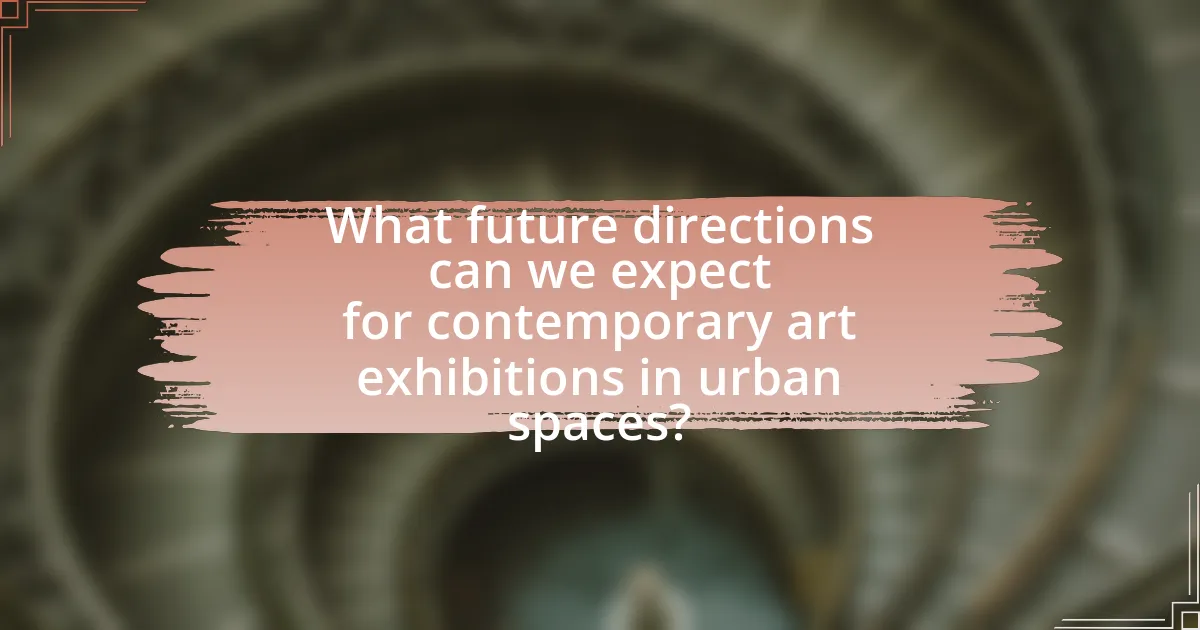
What future directions can we expect for contemporary art exhibitions in urban spaces?
Future directions for contemporary art exhibitions in urban spaces will increasingly focus on digital integration and community engagement. As technology advances, exhibitions will likely incorporate augmented reality and virtual reality elements, allowing for immersive experiences that blend physical and digital art. Additionally, urban art exhibitions will prioritize inclusivity by involving local communities in the curation process, fostering a sense of ownership and representation. This trend is supported by the rise of participatory art practices, which have shown to enhance public interaction and appreciation for art in urban environments.
How might urbanization trends affect the evolution of art exhibitions?
Urbanization trends significantly influence the evolution of art exhibitions by transforming the spaces where art is displayed and altering audience engagement. As cities grow, they often prioritize public spaces, leading to an increase in outdoor and community-based art exhibitions that are accessible to a broader audience. For instance, the rise of urban art festivals, such as the Mural Festival in Montreal, showcases how urban environments can serve as canvases, promoting local artists and enhancing community identity. Additionally, urbanization fosters technological advancements, enabling interactive and immersive art experiences, as seen in exhibitions like the Van Gogh Immersive Experience, which utilizes digital projections to engage viewers in urban settings. These trends indicate a shift towards inclusivity and innovation in art exhibitions, reflecting the dynamic nature of urban life.
What emerging technologies could redefine the experience of art in urban settings?
Emerging technologies such as augmented reality (AR), virtual reality (VR), and artificial intelligence (AI) are poised to redefine the experience of art in urban settings. AR can overlay digital art onto physical spaces, allowing viewers to interact with artworks in real-time, enhancing engagement and accessibility. For instance, the use of AR in public art installations has been demonstrated in projects like “The Night Cafe” in 2018, which recreated Van Gogh’s famous painting in a 3D environment accessible via mobile devices. VR offers immersive experiences that transport users into virtual galleries or artistic environments, as seen in the “VR Art Gallery” initiative, which allows users to explore art from around the world without geographical limitations. AI can analyze audience preferences and curate personalized art experiences, as evidenced by platforms like Artfinder, which uses algorithms to recommend artworks based on user behavior. These technologies not only enhance the interaction between the audience and art but also expand the possibilities for artists to create and exhibit their work in innovative ways.
How will changing urban landscapes influence the themes of future exhibitions?
Changing urban landscapes will significantly influence the themes of future exhibitions by reflecting the dynamic relationship between art and the evolving environment. As cities undergo transformations due to factors like gentrification, climate change, and technological advancements, exhibitions will increasingly focus on themes such as sustainability, community identity, and urban resilience. For instance, exhibitions may showcase artworks that address the impact of urbanization on local cultures or highlight innovative solutions to environmental challenges, thereby engaging audiences in critical dialogues about their surroundings. This trend is supported by the rise of site-specific installations and public art projects that respond directly to the unique characteristics of urban spaces, emphasizing the importance of context in contemporary art.
What best practices should be considered for organizing successful urban art exhibitions?
Successful urban art exhibitions should prioritize community engagement, strategic location selection, and effective marketing. Engaging the local community fosters a sense of ownership and encourages attendance, as seen in initiatives like the “Art in the Streets” exhibition at the Museum of Contemporary Art in Los Angeles, which involved local artists and community input. Selecting strategic locations, such as high-traffic urban areas, enhances visibility and accessibility, which is crucial for attracting diverse audiences. Effective marketing through social media and partnerships with local businesses can amplify reach and generate buzz, as demonstrated by the success of the “Bushwick Collective” in Brooklyn, which utilized social media to draw thousands of visitors. These best practices collectively contribute to the success and sustainability of urban art exhibitions.
How can curators effectively engage with local communities during exhibitions?
Curators can effectively engage with local communities during exhibitions by incorporating community input into the exhibition planning process. This approach fosters a sense of ownership and relevance among local residents, as evidenced by the success of projects like the “Community Curators” initiative in the UK, which involved local artists and residents in the curation process, resulting in increased attendance and participation. Additionally, hosting workshops, discussions, and events that reflect local culture and issues can enhance community involvement, as demonstrated by the “Art in the Park” program in Chicago, which attracted diverse audiences and encouraged dialogue around social themes. By prioritizing collaboration and local relevance, curators can create exhibitions that resonate with and actively involve the community.
What strategies can be implemented to enhance visitor experience in urban art exhibitions?
To enhance visitor experience in urban art exhibitions, implementing interactive installations is essential. These installations engage visitors actively, allowing them to participate in the art rather than passively observe. For instance, exhibitions that incorporate augmented reality (AR) can provide immersive experiences, as seen in the “Artivive” platform, which allows users to interact with artworks through their smartphones, creating a dynamic connection between the viewer and the piece. Additionally, offering guided tours led by knowledgeable curators can deepen understanding and appreciation of the art, as evidenced by studies showing that guided experiences increase visitor satisfaction and retention of information. Furthermore, integrating community involvement through workshops or artist talks fosters a sense of belonging and connection to the local culture, enhancing the overall experience.
